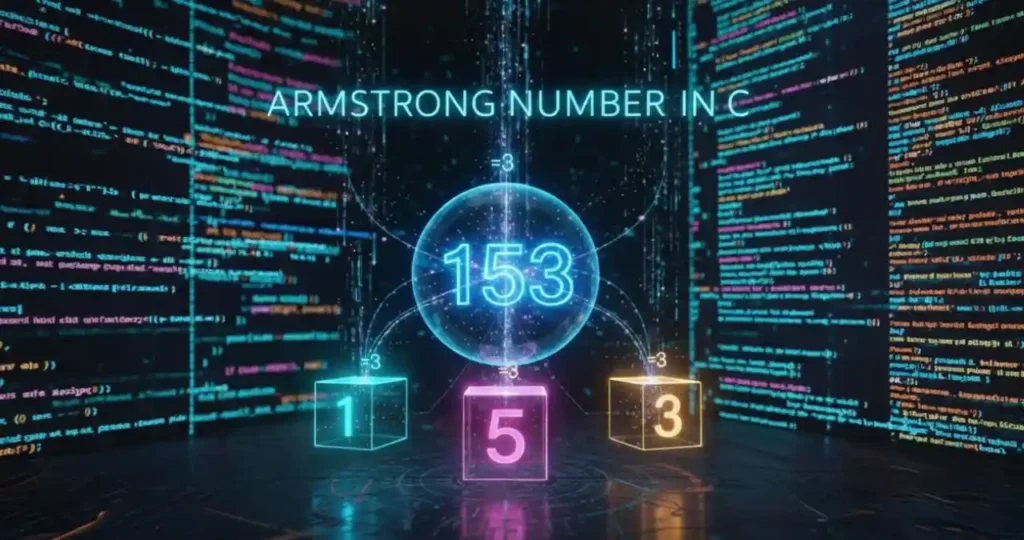An Armstrong number is one of the most popular programming exercises for beginners. Finding an Armstrong Number in C is like solving a puzzle, yet this is where many programmers stumble due to simple errors.
If you are someone who is still tangled up in complex codes, I have the easiest methods for you. If you know the common errors beforehand, wouldn’t it be easier to develop a simple code from the very beginning?
So, let’s understand what an Armstrong number is, some examples, core logic, and some common mistakes beginners often make. Don’t worry, I have solutions too! Let me step you through a simple C programming solution to write error-free code.
What Is an Armstrong Number?
An Armstrong number is also known as a “Narcissistic number”. A senior system programmer, Michael F. Armstrong, at the University of Rochester Computer Center, introduced the core idea of this mathematical computing. However, it is a mystery how his name got attached to this concept.
The Armstrong Numbers are equal to the sum of their own digits, and each digit is raised to the power of the total number. Confusing? Just look at the examples for better understanding:
Example of Armstrong Numbers
For 0: (0¹) = 0
For 1: (11) = 1 [from 0 to 9, each one is an Armstrong Number]
For 153: (1³ + 5³ + 3³) = 153
For 370: (3³ + 7³ + 0³) = 370
For 1634: (1⁴ + 6⁴ + 3⁴ + 4⁴) = 1634
So, is 371 an Armstrong number? Calculate yourself and let me know.
Formula & Core Logic
🔷 Formula
For a number with “n” digits:
abcd… = (a^n)+(b^n)+(c^n)+(d^n)+…
[The symbol ^ is used to denote raising to a power.]
Where:
- “n” = number of digits
- “a”, “b”, “c”, “d” = digits of the number
🔷 Core Logic
- Count digits → Find how many digits (n) the number has.
- Separate digits → Extract each digit using modulus (%) and division (/).
- Apply power → Raise each digit to the power of n.
- Sum them up → Add all powered digits.
- Check condition → If the sum equals the original number, it’s an Armstrong Number.
Now let’s get into the final action!
Primary Way to Check Armstrong Number in C
There are four basic methods of writing code using the C language: using loops, using recursion, using functions, and using math libraries (pow() function). The easiest are using string loops and recursion. Let’s find the codes and detailed explanation below:
Recursive Method
C Programming Code
| #include <stdio.h> #include <math.h> // Function to count digits int countDigits(int num) { int count = 0; while (num != 0) { count++; num /= 10; } return count; } // Recursive function to calculate Armstrong sum int armstrongSum(int num, int power) { if (num == 0) return 0; int digit = num % 10; return pow(digit, power) + armstrongSum(num / 10, power); } int main() { int num; printf(“Enter a number: “); scanf(“%d”, &num); int digits = countDigits(num); int sum = armstrongSum(num, digits); if (sum == num) printf(“%d is an Armstrong Number.\n”, num); else printf(“%d is not an Armstrong Number.\n”, num); return 0; } |
Explanation
Step 1: Count digits (countDigits)
- Use a “while” loop to divide the number by 10 repeatedly.
- Each division removes the last digit.
- Increment a counter each time.
- Example: 153 → digits = 3
Step 2: Calculate Armstrong sum (armstrongSum)
- Recursive function:
- Take last digit: digit = num % 10
- Raise it to the power of total digits: pow(digit, power)
- Call the same function on the remaining number: armstrongSum(num / 10, power)
- Add step 2 + step 3
- Base case: when num == 0, return 0
Example for 153:
Last digit 3 → 3³ = 27
Remaining 15 → calculate 1³ + 5³ = 126
Total sum = 27 + 126 = 153 ✅
Step 3: Check if it’s Armstrong
- If “sum == original number” → it’s Armstrong
- Else → it’s not
Step 4: Program flow
- Take the input number from the user.
- Count the number of digits.
- Calculate the Armstrong sum recursively.
- Compare the sum with the original number.
- Print the result.
Key Notes for Beginners
- % → get last digit of a number
- / → remove the last digit of a number
- pow(a, b) → raise a to the power b
- Recursion → function calls itself until a base condition is reached
String-based Method
C Programming Code
| #include <stdio.h> #include <math.h> #include <string.h> #include <stdlib.h> // <- Add this for atoi() int main() { char numStr[20]; / / To store number as string int sum = 0; printf(“Enter a number: “); scanf(“%s”, numStr); int length = strlen(numStr); // Count number of digits // Loop through each character (digit) in the string for (int i = 0; i < length; i++) { int digit = numStr[i] – ‘0’; // Convert char to int sum += pow(digit, length); // Add digit^length to sum } int num = atoi(numStr); // Convert string back to integer if (sum == num) printf(“%d is an Armstrong Number.\n”, num); else printf(“%d is not an Armstrong Number.\n”, num); return 0; } |
Explanation
Step 1: Include headers
- stdio.h → input/output
- math.h → pow() function
- string.h → strlen() function
- stdlib.h → atoi() function
Step 2: Store number as string
- scanf(“%s”, numStr); → reads the number as a string.
- Easier to access each digit directly.
Step 3: Find the number of digits
- int length = strlen(numStr); → counts the number of digits.
Step 4: Loop through each digit
- For each character in string:
- Convert to integer: digit = numStr[i] – ‘0’
- Raise to the power of digits: pow(digit, length)
- Add to the sum
Example (153):
1³ = 1
5³ = 125
3³ = 27
Total sum = 153
Step 5: Convert string to integer
- int num = atoi(numStr); → converts string “153” to integer 153.
- Needed to compare the sum with the original number.
Step 6: Check Armstrong condition
- if (sum == num) → number is Armstrong.
- Else → number is not Armstrong.
Common Errors & Quick Fixes
🟥 Recursion Method Errors
- Not including math.h for pow()
- Error: implicit declaration of function ‘pow’
- Fix: Add #include <math.h>
- Integer overflow
- Using int for very large numbers → pow(digit, power) can exceed int limit.
- Fix: Use long long for sum and input if numbers can be large.
- Infinite recursion
- Forgetting base case (if(num==0) return 0;)
- Fix: Always include the base case in the recursion to stop function calls.
- Wrong digit extraction
- Error: Using % incorrectly or not dividing the number by 10.
- Fix: Use digit = num % 10 and num / 10 correctly in recursion.
- Negative numbers
- The code may not handle negative inputs correctly.
- Fix: Either restrict input to positive numbers or take absolute value: num = abs(num);
🟥 String-based Method Errors
- Not including stdlib.h for atoi()
- Error: implicit declaration of function ‘atoi’
- Fix: Add #include <stdlib.h>
- Incorrect character-to-integer conversion
- Mistake: Using int digit = numStr[i]; instead of numStr[i] – ‘0’
- Fix: Always subtract ‘0’ to get an integer value.
- Buffer too small
- Mistake: Number exceeds array size of char numStr[20];
- Fix: Increase array size or validate input length.
- Floating-point errors with pow()
- pow() returns double → sum may be slightly off for large numbers.
- Fix: Round the result or cast to integer: (int)pow(digit, length)
- Non-numeric input
- User enters letters → code crashes or gives wrong results.
- Fix: Validate input to ensure only digits are entered.
Conclusion
Even though you understand what Armstrong numbers are and the mathematical logic behind them, finding them through programs requires practice. The key to easy code development is constant practice.
I hope you have found the above code methods for Armstrong Number in C easy and beginner-friendly. Try it yourself and let me know through the comments if you face any potential errors. Stay connected to learn programming concepts better!


